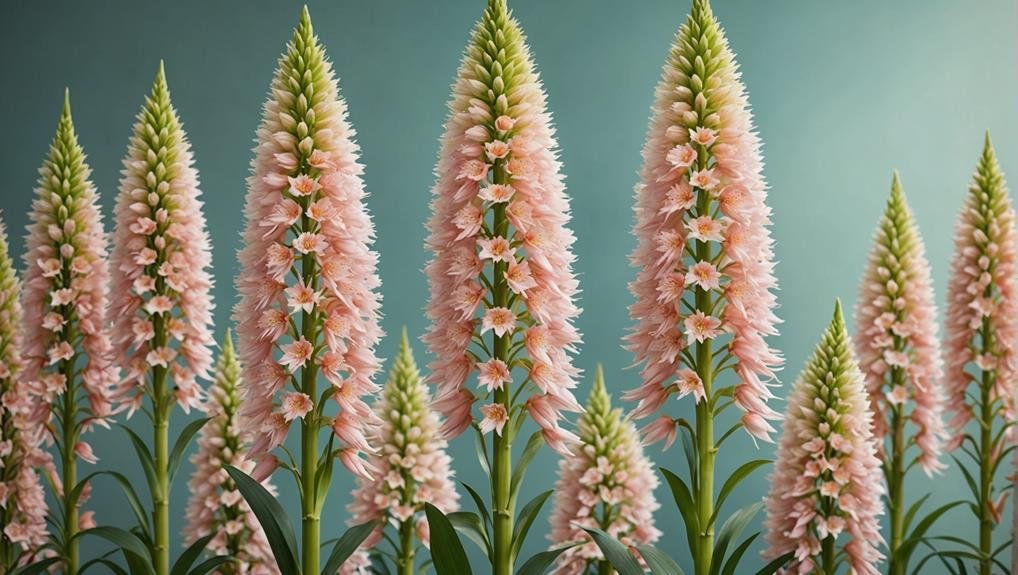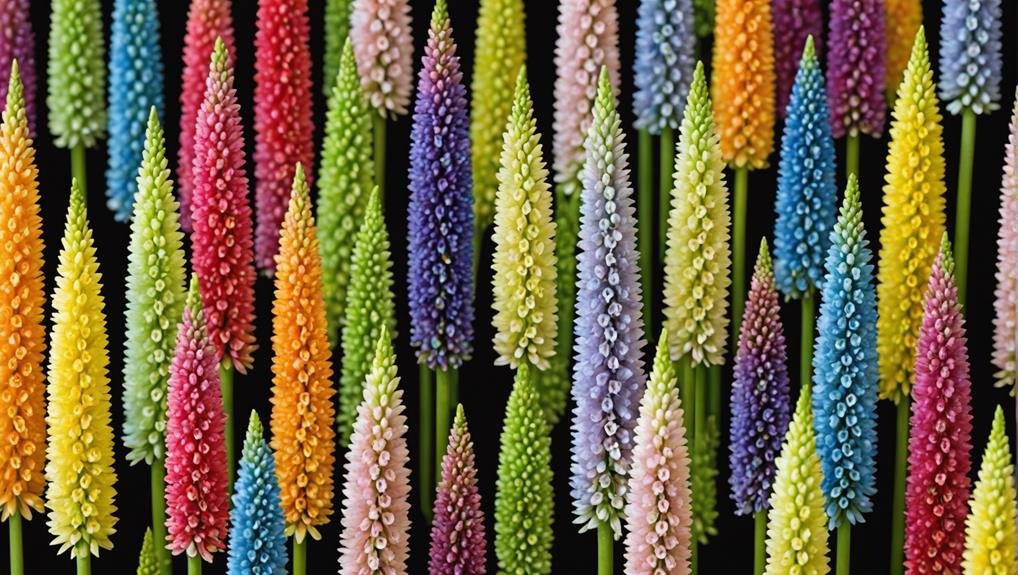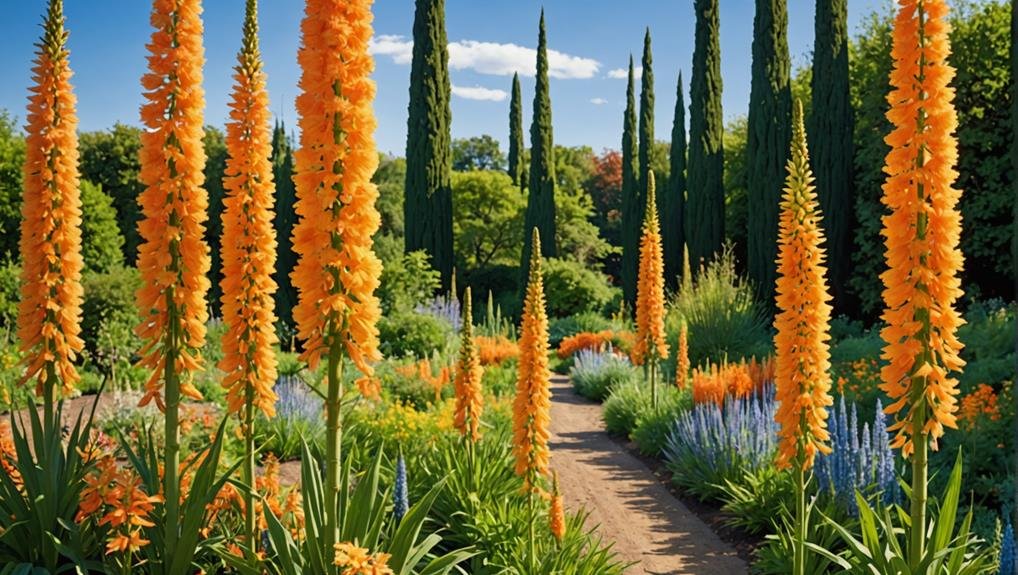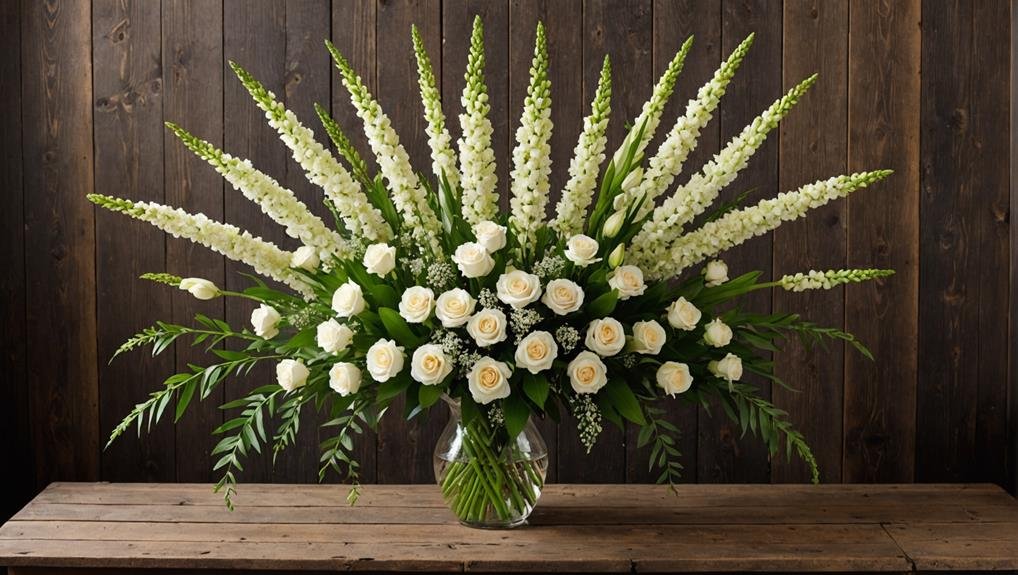Eremurus, commonly known as Foxtail Lily, is a enchanting choice for wedding floral arrangements due to its towering flower spikes adorned with star-shaped blooms in various hues such as white, yellow, pink, and orange. Blooming from late spring to mid-summer, it not only adds vertical interest and drama to bouquets and centerpieces but also symbolizes endurance and hope, making it a meaningful addition to wedding decor. To understand how this unique flower can transform wedding aesthetics and convey profound messages, consider its physical attributes, cultural significance, and best growing conditions.
Flower Overview

Eremurus, commonly known as Foxtail Lily, are tall and majestic perennials renowned for their impressive flower spikes that can reach heights of 4 to 8 feet. These striking plants are celebrated for their vertical presence and visual appeal in floral arrangements. The flower spikes of Eremurus are characterized by round spires adorned with numerous small, star-shaped flowers, which bloom in a dazzling array of colors including white, yellow, pink, and orange.
Blooming for several weeks from late spring to mid-summer, Foxtail Lilies offer an extended period of floral beauty. This extended blooming period makes them an attractive option for wedding floral arrangements, ensuring that their vibrant colors and distinct structure can be enjoyed throughout the event. The star-shaped flowers contribute a delicate yet sophisticated aesthetic, enhancing the overall elegance of bouquets and centerpieces.
In addition to their visual appeal, Eremurus is also deer and rabbit resistant. This characteristic makes them a practical choice for outdoor wedding settings, as they are less likely to be damaged by browsing animals.
Physical Description
The impressive stature of Foxtail Lilies is complemented by their long, slender, grass-like leaves that wither during blooming, allowing the tall, round spires adorned with star-shaped flowers to take center stage. These majestic perennials can reach heights of 4-8 feet, creating a striking vertical element in any floral arrangement.
The flower spires, often towering up to 140 cm, are densely packed with small, star-shaped blooms that offer a spectacular display during their blooming season, which spans late spring to mid-summer.
Foxtail Lilies, known for their structural elegance, require good drainage to thrive and showcase their full potential. The flowers can be seen in various hues, including pink flowers that add a soft touch to their otherwise bold presence.
The slender leaves of the plant, which resemble long blades of grass, gracefully retreat as the blooms emerge, ensuring that the tall flower spikes remain the focal point.
These blooms not only add a dramatic flair to wedding arrangements but also demonstrate the blend of beauty and resilience in nature. With their towering flower spires and delicate star-shaped flowers, Foxtail Lilies are indeed a captivating choice for any floral setting.
Available Colour Varieties

Available in a spectrum of colors, Foxtail Lilies offer versatility for diverse wedding themes and floral arrangements. Their wide range of hues allows brides and floral designers to create both romantic and vibrant displays, making Eremurus a popular choice for wedding bouquets and centerpieces. Common color options include soft pastel shades such as pale pink and creamy white, as well as more striking colors like tangerine orange and golden yellow.
The table below highlights the various color varieties of Eremurus, helping you visualize their potential impact on your wedding decor:
| Color Variety | Description | Popular Uses |
|---|---|---|
| Yellow | Bright and cheerful | Adds a pop of color to bouquets and arches |
| White | Classic and elegant | Ideal for traditional and minimalist themes |
| Pink | Soft and romantic | Perfect for pastel-themed arrangements |
| Orange | Bold and vibrant | Complements autumnal and modern designs |
Yellow Eremurus varieties, for instance, are especially favored for their ability to brighten up any floral arrangement. Whether integrated into a bouquet or used as a striking centerpiece, their golden hues can create a lively atmosphere. Similarly, white and pink varieties offer a timeless elegance, fitting seamlessly into various wedding styles. Orange Eremurus, with their bold presence, can add a dynamic touch to any wedding setting.
Latin Name and Taxonomy
Known commonly as Foxtail Lily, Eremurus belongs to the Asphodelaceae family and is classified under the Eremurus genus. The Latin name for this striking plant, Eremurus, is derived from the Greek words ‘eremos’ meaning desert and ‘oura’ meaning tail, aptly describing its appearance and natural habitat.
Eremurus is a herbaceous perennial renowned for its tall, showy flower spikes, making it a popular choice for wedding flower arrangements. Taxonomically, Eremurus falls under the order Asparagales and the tribe Asphodeloideae within the Asphodelaceae family. This classification situates the plant within a broader group of monocotyledonous flowering plants, known for their unique floral structures and growth habits.
The genus Eremurus encompasses several species, each exhibiting subtle variations in form and coloration, yet all share the distinctive tall, spiky inflorescence characteristic of the Foxtail Lily. Understanding the Latin name and taxonomy of Eremurus is invaluable for florists and brides-to-be, ensuring that the appropriate species and varieties are selected to complement the aesthetic and theme of the wedding.
Mastery of these botanical details enhances the ability to create stunning, cohesive floral displays that highlight the natural elegance of the Eremurus.
Geographical Origins

Originating from the arid regions of western and central Asia, Eremurus, commonly known as Foxtail Lily, thrives in the diverse landscapes of Afghanistan, Iran, Turkey, and the Himalayas. These regions, characterized by their dry climates and well-drained, sandy soils, provide the ideal conditions for this striking plant, also affectionately referred to as Desert Candles.
Eremurus is native to western Asia, where the plant has adapted to survive in the often harsh and variable conditions of its natural habitat. The geographical origins of Eremurus (Foxtail Lily) influence its cultivation requirements, as it favors environments that replicate its native, arid landscapes. The well-drained, sandy soils of its homeland are vital for preventing root rot and ensuring healthy growth.
The regions where Eremurus naturally grows experience distinct seasonal changes, which play an important role in the plant’s growth and flowering patterns. This adaptation to seasonal variability allows Eremurus (Foxtail Lily) to flourish in gardens and landscapes that can replicate these conditions.
Understanding the geographical origins of Eremurus is crucial for horticulturists and gardeners aiming to cultivate this spectacular plant successfully, ensuring it remains a stunning addition to any floral arrangement or garden setting.
Season Availability
Blooming mainly from late spring to mid-summer, Eremurus (Foxtail Lily) offers a seasonal spectacle that makes it a sought-after choice for wedding floral arrangements during these months. The impressive flower spikes of Eremurus, often towering over other blooms, bring height and drama to any floral design, which is particularly favored in bridal bouquets and centerpieces.
This seasonal availability guarantees that wedding florists can leverage Eremurus during peak wedding season, adding a unique and elegant touch to their creations. The long-lasting nature of Eremurus blooms, which can thrive for several weeks, ensures that they remain vibrant from the ceremony to the reception, providing enduring beauty throughout the event.
| Season | Availability |
|---|---|
| Late Spring | High |
| Early Summer | High |
| Mid-Summer | Moderate |
| Late Summer | Low |
| Fall & Winter | Not Available |
With colors ranging from yellow, pink, orange, to white, Eremurus offers versatility in matching various wedding color palettes. This adaptability, combined with its striking appearance, makes it a favorite among wedding florists aiming to create memorable and impactful floral displays.
Growing Conditions

Eremurus (Foxtail Lily) thrives in environments with full sunlight and well-drained, sandy soil, making these conditions necessary for its optimal growth and striking display. To plant Foxtail lilies successfully, one must carefully consider their growing conditions to guarantee their vibrant and tall stems reach their full potential.
Full sun and well-drained soil are non-negotiable for Eremurus, as these plants require ample light and quick drainage to thrive. Without these conditions, they may suffer from poor growth or rot.
Additionally, proper spacing is essential to prevent crowding, which can hinder the plant’s development. To achieve best results, follow these guidelines:
- Choose a sheltered location: This helps avoid the need for staking the tall stems.
- Ensure good drainage: Quick drainage is vital for the plant’s establishment and overall health.
- Plant in the back of a border: This prevents crowding and allows the stems to display their full height.
- Avoid overcrowding: Eremurus needs plenty of space to flourish without competition from neighboring plants.
Cultural Significance
Beyond their specific growing conditions, Foxtail Lilies hold a deep cultural significance in wedding florals, symbolizing endurance and perseverance. Their tall, striking flower spikes add a dramatic element to wedding bouquets, making them a favored choice among florists for creating memorable and impactful floral designs.
The vibrant colors of Eremurus not only enhance the aesthetic appeal of wedding decorations but also embody a sense of passion and excitement, which are essential sentiments in wedding celebrations. Foxtail Lily’s unique appearance makes it a popular focal point in bridal bouquets and centerpieces. Its symbolism of hope and new beginnings align seamlessly with the themes of marriage and lifelong commitment.
By incorporating Eremurus into floral designs, couples can convey messages of everlasting love and the strength needed to endure life’s challenges together. In bridal bouquets, Eremurus creates a sense of elegance and sophistication, complementing various wedding themes from traditional to contemporary.
The cultural significance of this flower extends beyond its beauty, offering a deeper connection to the values and emotions that weddings represent. Therefore, Foxtail Lilies stand as a timeless choice for couples seeking meaningful and visually stunning wedding florals.
Typical Use in Weddings

Known for its structural elegance and vibrant hues, the Foxtail Lily is frequently utilized in wedding floral arrangements to create visually striking displays. Eremurus, with its tall and striking stems, offers a dramatic presence that can transform any wedding setting into an enchanting space. Its vibrant colors, ranging from tangerine to yellow, provide a lively pop of color that enhances bouquets and centerpieces alike.
Incorporating Eremurus into wedding floral arrangements provides several benefits:
- Height and Drama: The tall, striking stems of Eremurus add height and drama to any arrangement, making it ideal for creating statement pieces.
- Vibrant Colors: The bright hues of Eremurus inject a burst of color, adding vibrancy to wedding decor.
- Structural Elegance: The structural elegance of the Foxtail Lily lends a sophisticated touch to floral designs.
- Exotic Appeal: The star-shaped flowers contribute a unique and exotic flair, enhancing the overall aesthetic of the event.
Florists and couples alike seek the Foxtail Lily for its ability to create memorable and eye-catching displays. Whether used in bouquets, centerpieces, or as standalone arrangements, Eremurus offers an unparalleled wow factor, elevating the visual impact of wedding celebrations.
Alternative Flower Types
When considering alternative flower types for wedding arrangements, Allium, Agapanthus, Gladiolus, and Delphinium stand out for their unique forms and vibrant colors. These flowers provide a variety of textures and shapes, ensuring an enchanting aesthetic for any wedding theme.
Allium offers spherical blooms in various sizes and hues, adding an intriguing architectural element to floral designs. Their distinctive round forms can create focal points in bouquets and centerpieces, making them a versatile choice for modern and classic styles alike.
Agapanthus, also known as Lily of the Nile, features clusters of trumpet-shaped flowers on tall stems. These blossoms are perfect for creating a striking visual impact, whether used in tall arrangements or as part of a cascading bouquet. Their elegant form and blue to purple shades complement a wide range of color palettes.
Gladiolus presents elegant, sword-like flower spikes in a wide array of hues. These blossoms are ideal for adding height and drama to bouquets and centerpieces, bringing a sense of sophistication and grandeur to wedding decor.
Delphinium showcases tall spires of densely packed flowers in shades of blue, pink, purple, or white. These vibrant blooms enhance the overall aesthetic of wedding floral arrangements, providing a lush, garden-like feel that is both romantic and timeless.
